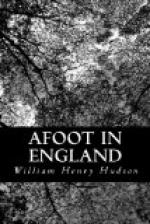To be near the spot I went to stay at Shrewton, a downland village four miles from “The Stones”; or rather a group of five pretty little villages, almost touching but distinct, like five flowers or five berries on a single stem, each with its own old church and individual or parish life. It is a pretty tree-shaded place, full of the crooning sound of turtle-doves, hidden among the wide silent open downs and watered by a clear swift stream, or winter bourne, which dries up during the heats of late summer, and flows again after the autumn rains, “when the springs rise” in the chalk hills. While here, I rambled on the downs and haunted “The Stones.” The road from Shrewton to Amesbury, a straight white band lying across a green country, passes within a few yards of Stonehenge: on the right side of this narrow line the land is all private property, but on the left side and as far as one can see it mostly belongs to the War Office and is dotted over with camps. I roamed about freely enough on both sides, sometimes spending hours at a stretch, not only on Government land but “within bounds,” for the pleasure of spying on the military from a hiding-place in some pine grove or furze patch. I was seldom challenged, and the sentinels I came across were very mild-mannered men; they never ordered me away; they only said, or hinted, that the place I was in was not supposed to be free to the public.
I come across many persons who lament the recent great change on Salisbury Plain. It is hateful to them; the sight of the camp and troops marching and drilling, of men in khaki scattered about everywhere over a hundred square leagues of plain; the smoke of firing and everlasting booming of guns. It is a desecration; the wild ancient charm of the land has been destroyed in their case, and it saddens and angers them. I was pretty free from these uncomfortable feelings.




